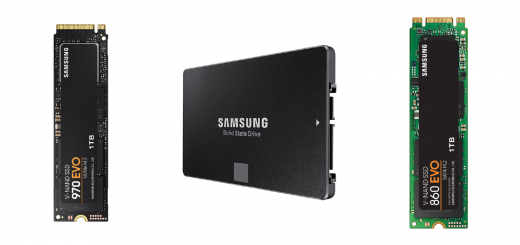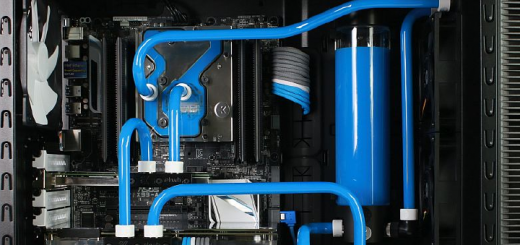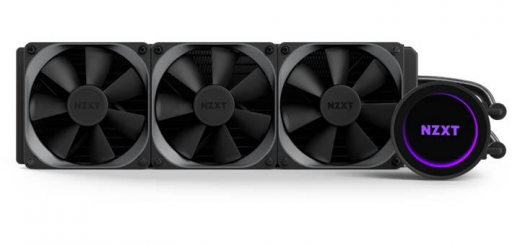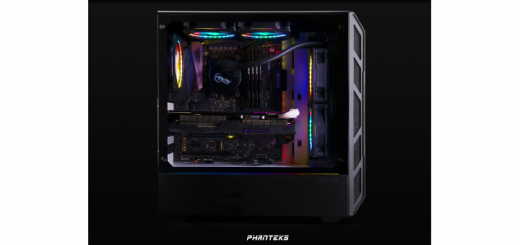AMD has officially announced its Ryzen 4000G Series of APUs. They feature Zen 2 Cores, the same as the ones used on Ryzen 3000 Series of CPUs, along with Vega CUs for graphics. Both the Zen 2 cores and Vega CUs in the Ryzen 4000G Series have been manufactured on the 7nm process. The products are right now limited to OEMs and system integrators.
AMD Ryzen 4000G Series Lineup
AMD Ryzen 4000G Series features the Renoir dies used in the Ryzen 4000 mobile APUs. It has been broadly categorized into two distinct segments based on TDP. The G Series of Ryzen 4000 APUs has products with a TDP rating of 65W. Meanwhile, the GE series has a TDP rating of 35W. There are three APUs in each series featuring 4, 6, and 8 cores.
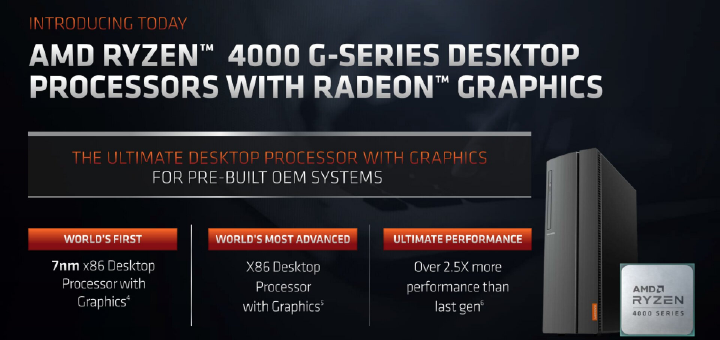
AMD Ryzen 4000G 65W APUs
Ryzen 3 4300G is the entry-level offering with 4-cores and 8-threads. It has a base clock of 3.8GHz and a boost clock of 4.0GHz along with a 6MB cache. There are 6 Vega graphics cores clocked at 1700MHz.
Ryzen 5 4600G is the mid-range offering with 6-cores and 12-threads. The base clock and boost clocks are 3.7GHz and 4.2 GHz, respectively. It has a 12MB cache and features 7 Vega graphics cores at 1900 MHz.
The top-end offering is the Ryzen 7 4700G with 8-cores and 16-threads. It is the highest clocked out of the lot with a boost clock of 4.4GHz, although the base clock is the lowest at 3.6GHz. The APU uses a Cache of 12MB and comes with 8 Vega graphics cores clocked at 2100MHz.
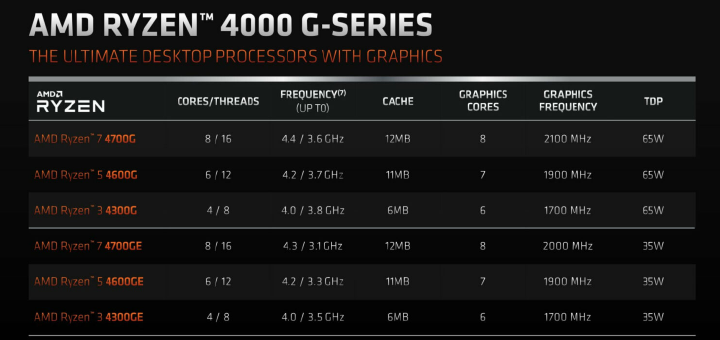
AMD Ryzen 4000G 35W APUs
Ryzen 3 4300GE is the base offering with 4-cores and 8-threads. Its base and boost clocks are 3.5GHz and 4.0GHz, respectively, and the cache is 6MB. There are 6 Vega compute units clocked at 1700MHz.
Ryzen 5 4600GE is the mid-range APU with 6-cores and 12-threads. The base clock is 3.3GHz, and the boost clock is 4.2 GHz. It has a 12MB cache and features 7 Vega graphics cores at 1900 MHz.
Ryzen 7 4700GE is the high-end product with 8-cores and 16-threads. The APU features a base clock of 3.1GHz and a boost clock of 4.3GHz. It employs a 12MB cache and comes with 8 Vega graphics cores clocked at 2000MHz.
Ryzen 4000G and GE Series of APUs will work with only 500 series of AM4 motherboards.
AMD Ryzen PRO 4000 APUs
Additionally, AMD launched Ryzen PRO 4000 Series APUs as well. Their specifications and TDP are exactly the same as the Ryzen G Series of CPUs. They come with more security features and are aimed at professionals. However, the PRO models will require separate AMD PRO565 chipset-based motherboards.
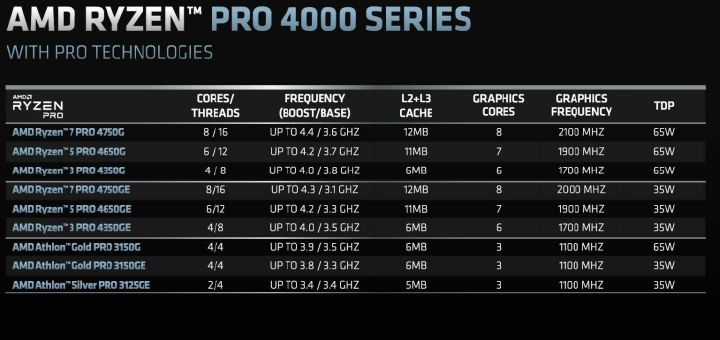
AMD also launched three entry-level Anthlon models for the budget segment. They are available in both the 4000G and PRO lineups
Ryzen 4000G APUs vs Ryzen 3000G APUs – What has changed?
When comparing AMD’s 4000G APU Series with its predecessor, the company has doubled the core and thread counts. Previously, there were two APUs available, the Ryzen 3 3200G with 4-cores and 4-threads, and the Ryzen 5 3400G with 4-cores and 8-threads. Now, the top variant features 8-cores and 16-threads while the base variant has 4-cores with SMT enabled. There is a new 6-core, 12-thread APU introduced as well. The increase in core count, along with the better Zen 2 architecture, will improve the performance of the Ryzen 4000G APUs significantly.
However, AMD has reduced the maximum number of GPU compute units from 11 to 8. But the 50% increase in clock speeds of the graphics cores (1,400Mhz to 2,100MHz) will boost GPU performance significantly. Overall, it may be slightly better than the graphics performance of the 3000G APUs.
When compared to the Ryzen 3000 desktop CPUs that also use Zen 2 cores, the 4000G APUs feature less cache. However, they have a monolithic design, whereas the 3000 Series of CPUs has a chiplet design. The low cache may not significantly impact the performance of the Ryzen 4000G APUs due to their monolithic design. It will only be seen once the benchmarks are out.
Ryzen 4000G APUs – Price and Availability
While the current AMD Ryzen 4000G launch is for OEMs, the APUs may become available for the retail desktop DIY market later. Enthusiasts who wanted to pick one of the APUs will have to wait. They may probably become available alongside Ryzen 4000 CPUs slated to launch later this year. We don’t have a price listing yet, as the CPUs are right now limited to system integrators and OEMs.

